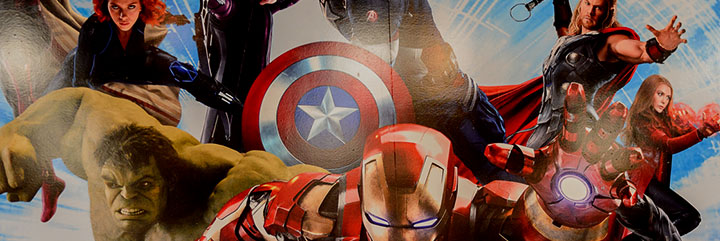ad spend
- Analytics & Data Science
- Article
How Data Science Is Upending the Ad Profession
What constitutes today’s “Mad Men” (or Women)? Clearly, data-driven marketing communications and customer management have changed the ad profession. But in the future who’s going to do the actual work of marketing, and which institutions will dominate? Harvard’s John Deighton dissects a media world dominated by the Internet’s “walled gardens,” IT consultants, and unrecognizable ad firms.
Member Only Access- Ad Effectiveness & ROI
- Article
The Optimal Way to Advertise Sequentially Released Products
Hollywood pumps out movie sequels like there’s no tomorrow. Why? Sequential distribution is critical to a company’s performance, not only for movies but also for other types of products. This article illustrates that how an advertising budget is allocated across product life stages or product formats over time can make or break success.
Member Only AccessForecast: U.S. Mobile Ad Spend Will More Than Double By 2021 via MediaPost (source:BIA/Kelsey)
According to a fresh forecast from BIA/Kelsey, 2021 U.S. annual mobile ad spending will reach $72 billion. That’s up from $33 billion last year, by the research firm’s reckoning. If accurate, mobile ad spending will see a 17% compound annual growth rate through 2021.
The smartphone’s location-tracking abilities and portability, combined with users’ transitory behavior, make location-targeted content a natural fit.
Of the overall mobile ad spend, the location-targeted portion is projected to grow from $12.4 billion in 2016 to $32.4 billion in 2021.
2016 Predictions and Trends
For the First Time, Advertising To Surpass $500 Billion In 2016
IHS analyst Eleni Marouli predicts 2016 ad spending in this Media Post article by Laurie Sullivan. “Advertising to Surpass $500 Billion in 2016” includes the prediction that advertising will rise 5.7% and video will become the new mobile. Initiatives around measurement in the advertising industry are also discussed by Sullivan.
See more...
Source: http://www.mediapost.com/publications/article/265493/advertising-to-surpass-500-billion-in-2016.html
IoT Will Become Omnipresent in Our Lives
Chuck Martin’s 2016 IoT predictions for Media Post include an extensive list from a variety of cited sources. Beacons, wearables, encryption technology, smart machines, and more are presented in, “2016 IoT Predictions: Big Data, Beacons, Wearables, Security.”
See more…
Source: http://www.mediapost.com/publications/article/265353/2016-iot-predictions-big-data-beacons-wearables.html
Fewer but More Creative Ads in 2016
Matt Sweeney, CEO of Xaxis North America, presents six of the top trends that will impact advertising in the year ahead. In this article for Campaign Live, “Better Creative, Fewer Ads: 6 Trends That Will Define 2016,” Sweeney predicts that ads will be more relevant and less intrusive.
See more…
Source: http://www.campaignlive.com/article/better-creative-fewer-ads-6-trends-will-define-2016/1377923
Native Advertising: FTC Guidance and IAB Concerns
The Internet Advertising Bureau (IAB) plans to seek additional clarification from the Federal Trade Commission (FTC) concerning the Commission’s recent Guidance on Native Advertising. Brad Weltman, Vice President, Public Policy at the IAB, discusses his concerns in this IAB press release, “IAB Concerned About FTC Guidance on Native Advertising.” While both organizations agree on the importance of clear disclosure to consumers, they disagree about other points in the Guidance.
See more…
Source: http://www.iab.com/news/iab-concerned-about-ftc-guidance-on-native-advertising/
Multichannel Online Behavior Can Predict Online Consumer Purchasing
This December 2015 article from the Journal of Advertising Research examines how consumer behavior across multiple online advertising channels can be used to predict conversions. The authors, Sebastian Klapdor, McKinsey & Company, Munich; Eva Anderl, FELD M, Munich; Jan H. Schumann, Universitat Passau, Germany, and Florian Von Wangenheim, ETH, Zurich, Switzerland, suggest strategies for advertisers to target individual consumers based on this research in this article, “How to Use Multichannel Behavior To Predict Online Conversions-Behavior Patterns Across Online Channels Inform Strategies For Turning Users Into Paying Customers.”
See more…
Source: http://www.thearf.org/journal-of-advertising-research-online-access/
Nearly 8 in 10 Advertisers Now Use Advanced TV and Most Plan to Increase Spend in the Next 12 Months, According to IAB Research
Some form of advanced TV has been used in marketing efforts by 78% of advertisers, according to the survey, “Advanced TV: Ad Buyer Perceptions.” In addition, 72% of marketers and agency executives surveyed believe that advanced TV will become an important advertising platform within five years. According to a press release by the Interactive Advertising Bureau (IAB), this survey was recently published by the IAB and its Digital Video Center of Excellence.
The current media budget allocation for advanced TV is $1.4 million; however, 70% of advertisers expect to increase their budget for this medium within the next 12 months. Funding is expected to come from both TV budgets (68% of respondents) and expanded or experimental ad budgets (54% of respondents). Addressable advertising, second screen ads, and interactive tags are among the advanced TV ad formats expected to increase in the next year.
The strongest benefits of advanced TV include:
-Better targeting capabilities.
-Ability to reach consumers anytime on any device.
-Improved ROI.
-Ability to personalize or localize messages.
Potential obstacles to the growth of advanced TV include:
-Marketplace confusion about this medium.
-Uncertainty about the differences between advanced TV and connected TV.
-A lack of understanding about advanced TV’s technical process.
-Concern about high costs.
The IAB is establishing a committee on the subject of advanced TV in response to member interest. The press release includes a link to the complete findings of this report.
See all 5 Cups articles.
Mobile to Overtake Newspapers
According to the latest Advertising Expenditure Forecasts from ZenithOptimedia, in 2016 mobile internet advertising will become the world’s third-largest advertising medium, behind television and desktop internet and ahead of newspapers.
The media agency’s forecasts show that next year mobile will account for 12.4% of global adspend while newspapers will take 11.9%. In terms of actual value, mobile advertising will grow 38% in 2016 to US$71bn, while newspaper advertising will shrink 4% to US$68bn.
Mobile advertising is the driving force behind the growth of the entire advertising market, ZenithOptimedia stated, as it will contribute 83% of all new ad dollars between 2014 and 2017. And as mobile continues its inexorable rise, so print continues to decline across most of the world. ZenithOptimedia predicts that newspaper adspend will shrink by an average of 4.9% a year through to 2017, while magazine advertising will shrink by 3.2% a year. Their combined share of global adspend will fall from 19.6% this year to 16.7% by 2017.
In that year, internet advertising is expected to account for 34% of global adspend, slightly behind television’s 35.9% and is likely to gain the top spot in 2018 on current trends. Total adspend is forecast to grow 4% this year to reach US$554bn before accelerating to 5% in 2016, thanks to the four-yearly boost supplied by the summer Olympics and US presidential election.
See all 5 Cups articles.
Traditional Out-of-Home Media Continues Growth
In contrast to the OOH advertising revenue growth, statistics from Kantar Media reveal that total ad spending in the United States was down almost 7% for the quarter, and OOH and local radio are the only traditional media with significant growth.
In this Research Brief From the Center for Media Research, Jack Loechner provides a ranking of top OOH advertisers, based on their spending, as released by the OAAA. This ranking includes:
-McDonald’s
-Apple
-Metro PCS
-Warner Bros Pictures
-Geico
The article includes this quote by Stephen Freitas, OAAA Chief Marketing Officer, “…the most significant trend in advertising today is the shift to digital… this hasn’t impacted OOH the way it has other traditional media, because OOH complements… digital marketing… especially mobile… the fastest growing of all digital platforms… ”
See all 5 Cups articles.
For more on this topic, check out the Media Tab in Morning Coffee.
Connected TV Spend to Rise, While Priority Remains Low
The Association of National Advertisers (ANA), in partnership with BrightLine, an ad platform, reports that more than 70% of 215 client-side senior marketers believe that connected TV represents an opportunity for the advertising industry. Despite this belief, none of these marketers spend more than 10% of their budget on connected TV.
YuYu Chen, summarizing this report for ClickZ, reports that 48% of respondents whose companies are currently engaged in connected TV or OTT devices plan to allocate more of their TV ad budget to it next year. In addition, another 13% of respondents not currently engaged in connected TV or OTT, plan to allocate some of their budget to it next year.
Top benefits of connected TV/OTT include:
- Audience targeting
- High engagement
- Amplification of video content
According to this report, barriers to greater spending on connected TV or OTT by marketers include:
- Lack of reliable measurement metrics
- Small-scale audiences
- Cost/pricing
- Creative concerns
- Budgets
- Not familiar enough (especially reported by respondents not currently engaged with connected TV/OTT)
Rob Aksman, founder and CEO of BrightLine, is optimistic about the future of connected TV. “There’s nothing stopping connected TV from going mainstream today: there’s scale, there’s targeting and there’s data. With connected TV, advertisers can not only reach TV viewers, but also offer a better brand experience with clickable and measurable videos.”
See all 5 Cups articles.
For more on this topic, check out the Media Tab in Morning Coffee.
Mobile Becoming the First Screen
Jack Loechner, writing for the Research Brief From the Center for Media Research, analyzes The Salesforce Marketing Cloud Report, and finds key changes in global mobile consumer behavior and the digital and advertising landscapes.
Among the findings:
-Mobile is increasingly becoming the first screen in terms of time spent by consumers with media.
-Combined, Facebook, Twitter, and LinkedIn experienced a 49% growth in ad revenue from Q1 2014 to Q1 2015.
-In 2014, digital advertising surpassed both broadcast and cable television revenue in the U.S. Digital advertising became the largest single channel and the fastest growing channel. Revenue in 2014 was almost $50 billion.
This report also reveals that the revolution in technology will foster tighter collaboration among marketing, sales, and service departments within corporations. It will also break down marketing silos, which negatively impact brand teams and agency relationships.
See all 5 Cups articles.
For more on this topic, check out the Media Tab in Morning Coffee.



